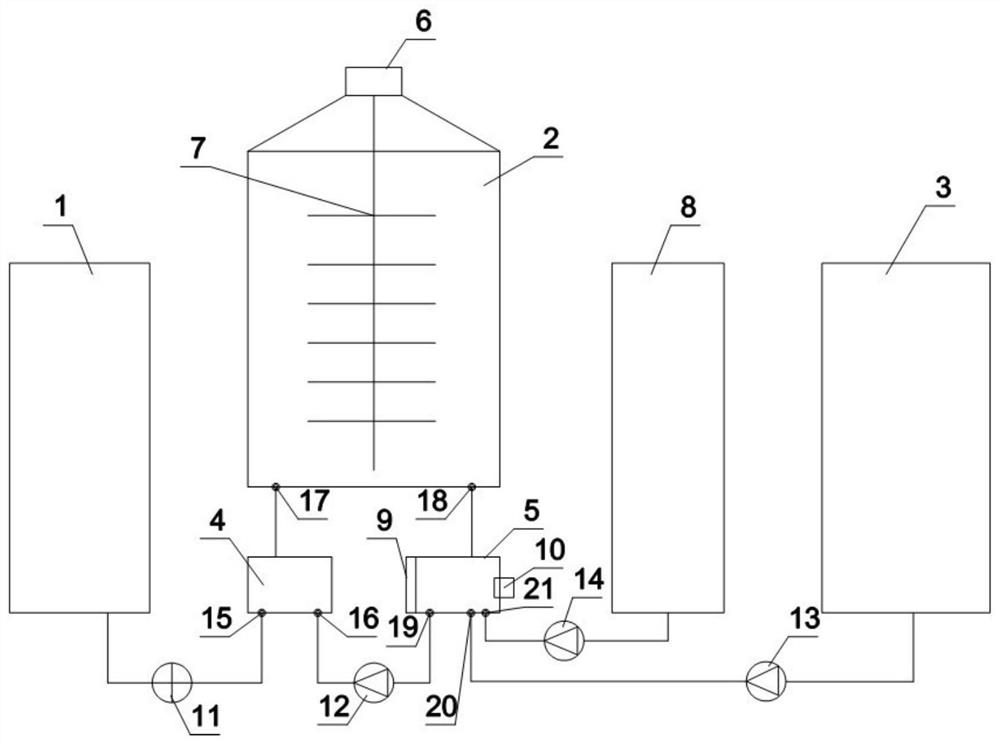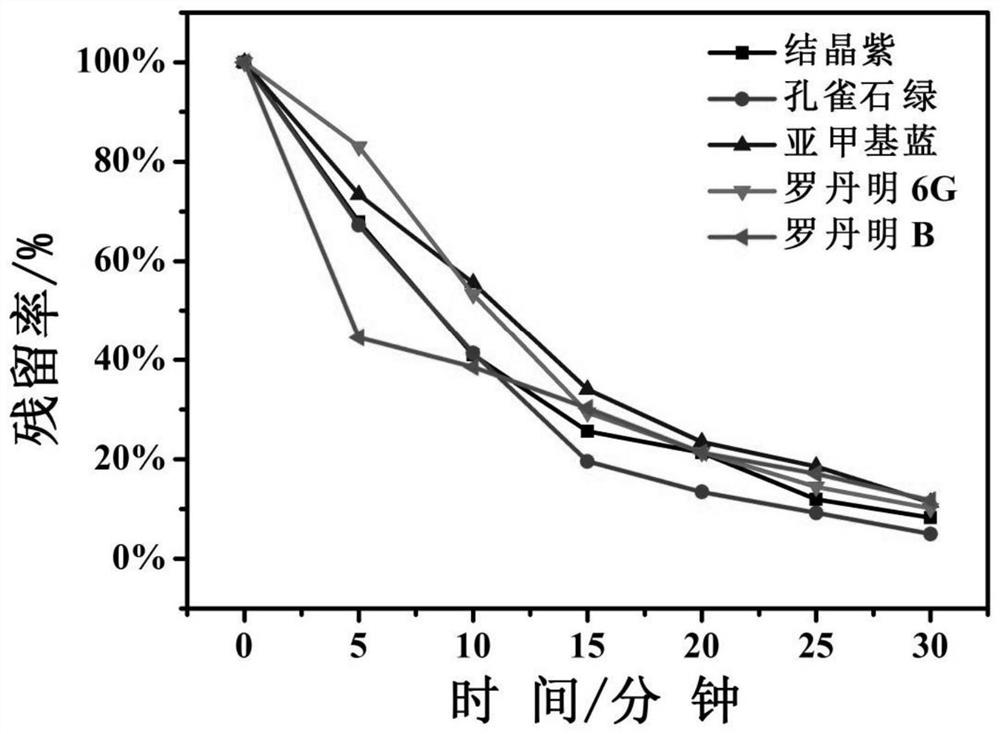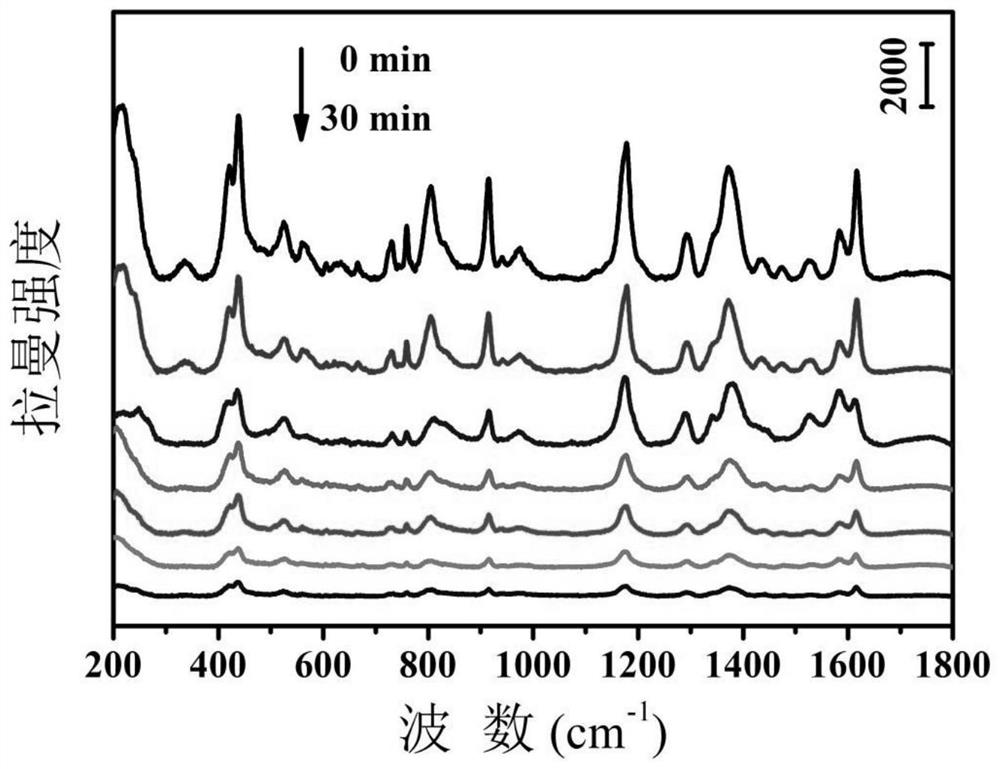Device and method for treating cationic dyes in sewage by using magnetic compound
A technology of cationic dyes and complexes, which is applied in the field of sewage treatment, can solve problems such as difficult separation and recovery, and achieve the effects of solving the difficulty of separation and recovery, improving treatment efficiency, and improving use efficiency
- Summary
- Abstract
- Description
- Claims
- Application Information
AI Technical Summary
Problems solved by technology
Method used
Image
Examples
Embodiment 1
[0054] Synthesis of magnetic complexes:
[0055] Prepare 0.15g / ml sodium acetate ethylene glycol dispersion, mix the sodium acetate ethylene glycol dispersion with 0.06g / ml ferric chloride ethylene glycol solution in a medium proportion, stir for 30 minutes, and place the mixture at 200°C React for 10 hours, magnetically separate the product, wash with water for 3 times, and dry the product at 50°C for 5 hours to obtain ferric oxide nanoparticles; configure 1% 3-aminopropyltriethoxysilane ethanol solution, take the Add triethoxysilane ethanol solution to 0.15 mg / mL ferric ferric oxide ethanol dispersion, stir for 24 hours, magnetically separate the product, wash with ethanol and water for 3 times, redisperse it in aqueous solution to obtain aminated ferric ferric oxide Aqueous solution: configure 100mL 0.01% chloroauric acid aqueous solution, take 1ml 1% sodium citrate aqueous solution and add it to the above chloroauric acid aqueous solution and stir for 1 minute, then take 1...
Embodiment 2
[0066] Synthesis of magnetic complexes:
[0067] Prepare 0.15g / ml sodium acetate ethylene glycol dispersion, mix the sodium acetate ethylene glycol dispersion with 0.06g / ml ferric chloride ethylene glycol solution in a medium proportion, stir for 30 minutes, and place the mixture at 200°C React for 10 hours, magnetically separate the product, wash with water for 3 times, and dry the product at 50°C for 5 hours to obtain ferric oxide nanoparticles; configure 1% 3-aminopropyltriethoxysilane ethanol solution, take the Add triethoxysilane ethanol solution to 0.15 mg / mL ferric ferric oxide ethanol dispersion, stir for 24 hours, magnetically separate the product, wash with ethanol and water for 3 times, redisperse it in aqueous solution to obtain aminated ferric ferric oxide Aqueous solution: configure 100mL 0.01% chloroauric acid aqueous solution, take 1ml 1% sodium citrate aqueous solution and add it to the above chloroauric acid aqueous solution and stir for 1 minute, then take 1...
Embodiment 3
[0078] Synthesis of magnetic complexes:
[0079] Prepare 0.15g / ml sodium acetate ethylene glycol dispersion, mix the sodium acetate ethylene glycol dispersion with 0.06g / ml ferric chloride ethylene glycol solution in a medium proportion, stir for 30 minutes, and place the mixture at 200°C React for 10 hours, magnetically separate the product, wash with water for 3 times, and dry the product at 50°C for 5 hours to obtain ferric oxide nanoparticles; configure 1% 3-aminopropyltriethoxysilane ethanol solution, take the Add triethoxysilane ethanol solution to 0.15 mg / mL ferric ferric oxide ethanol dispersion, stir for 24 hours, magnetically separate the product, wash with ethanol and water for 3 times, redisperse it in aqueous solution to obtain aminated ferric ferric oxide Aqueous solution: configure 100mL 0.01% chloroauric acid aqueous solution, take 1ml 1% sodium citrate aqueous solution and add it to the above chloroauric acid aqueous solution and stir for 1 minute, then take 1...
PUM
 Login to View More
Login to View More Abstract
Description
Claims
Application Information
 Login to View More
Login to View More - R&D
- Intellectual Property
- Life Sciences
- Materials
- Tech Scout
- Unparalleled Data Quality
- Higher Quality Content
- 60% Fewer Hallucinations
Browse by: Latest US Patents, China's latest patents, Technical Efficacy Thesaurus, Application Domain, Technology Topic, Popular Technical Reports.
© 2025 PatSnap. All rights reserved.Legal|Privacy policy|Modern Slavery Act Transparency Statement|Sitemap|About US| Contact US: help@patsnap.com



